Corporate Financial Management: Portfolio Analysis and M&A Assessment
VerifiedAdded on 2020/07/23
|19
|2973
|56
Report
AI Summary
This report provides an in-depth analysis of corporate financial management, focusing on portfolio analysis and a case study on Bayer's acquisition of Monsanto. Part A of the report calculates and compares monthly logarithmic returns of two portfolios: one constructed randomly and the other using technical analysis. Statistical methods, including independent sample t-tests, are employed to assess the significance of the return differences. The findings suggest that portfolios created through technical analysis generally outperform random portfolios. Furthermore, the report critically evaluates the findings in the context of the Weak Form of Market Efficiency (WFME) and random walk theory. Part B assesses the financial implications of Bayer's support for the Monsanto acquisition, considering capital structure, cost of capital, and shareholder wealth maximization. The analysis examines the impact of debt financing on Bayer's financial position and provides recommendations based on financial literature and debt-equity ratios. The report concludes with a discussion on the importance of strategic financial decisions in corporate finance.

Corporate Financial Management
Paraphrase This Document
Need a fresh take? Get an instant paraphrase of this document with our AI Paraphraser

TABLE OF CONTENTS
INTRODUCTION...........................................................................................................................3
PART A...........................................................................................................................................3
a. Calculating monthly logarithmic returns of the portfolio that include equally weighted 5
random companies.......................................................................................................................3
b. Creating an equally weighted portfolio by doing technical analysis and assessing monthly
returns..........................................................................................................................................5
c. Hypothesis framing..................................................................................................................6
d. Testing monthly logarithmic returns of both the portfolios by taking into account
independent sample t- test.........................................................................................................13
e. Discussion of findings derived through statistical evaluation...............................................14
f. Critically evaluating findings in the empirical study on WFME and random walk theory. . .14
PART B.........................................................................................................................................14
Assessing whether Bayer’s should support the deal pertaining to Monsanto’s acquisition......14
CONCLUSION..............................................................................................................................17
REFERENCES..............................................................................................................................18
INTRODUCTION...........................................................................................................................3
PART A...........................................................................................................................................3
a. Calculating monthly logarithmic returns of the portfolio that include equally weighted 5
random companies.......................................................................................................................3
b. Creating an equally weighted portfolio by doing technical analysis and assessing monthly
returns..........................................................................................................................................5
c. Hypothesis framing..................................................................................................................6
d. Testing monthly logarithmic returns of both the portfolios by taking into account
independent sample t- test.........................................................................................................13
e. Discussion of findings derived through statistical evaluation...............................................14
f. Critically evaluating findings in the empirical study on WFME and random walk theory. . .14
PART B.........................................................................................................................................14
Assessing whether Bayer’s should support the deal pertaining to Monsanto’s acquisition......14
CONCLUSION..............................................................................................................................17
REFERENCES..............................................................................................................................18
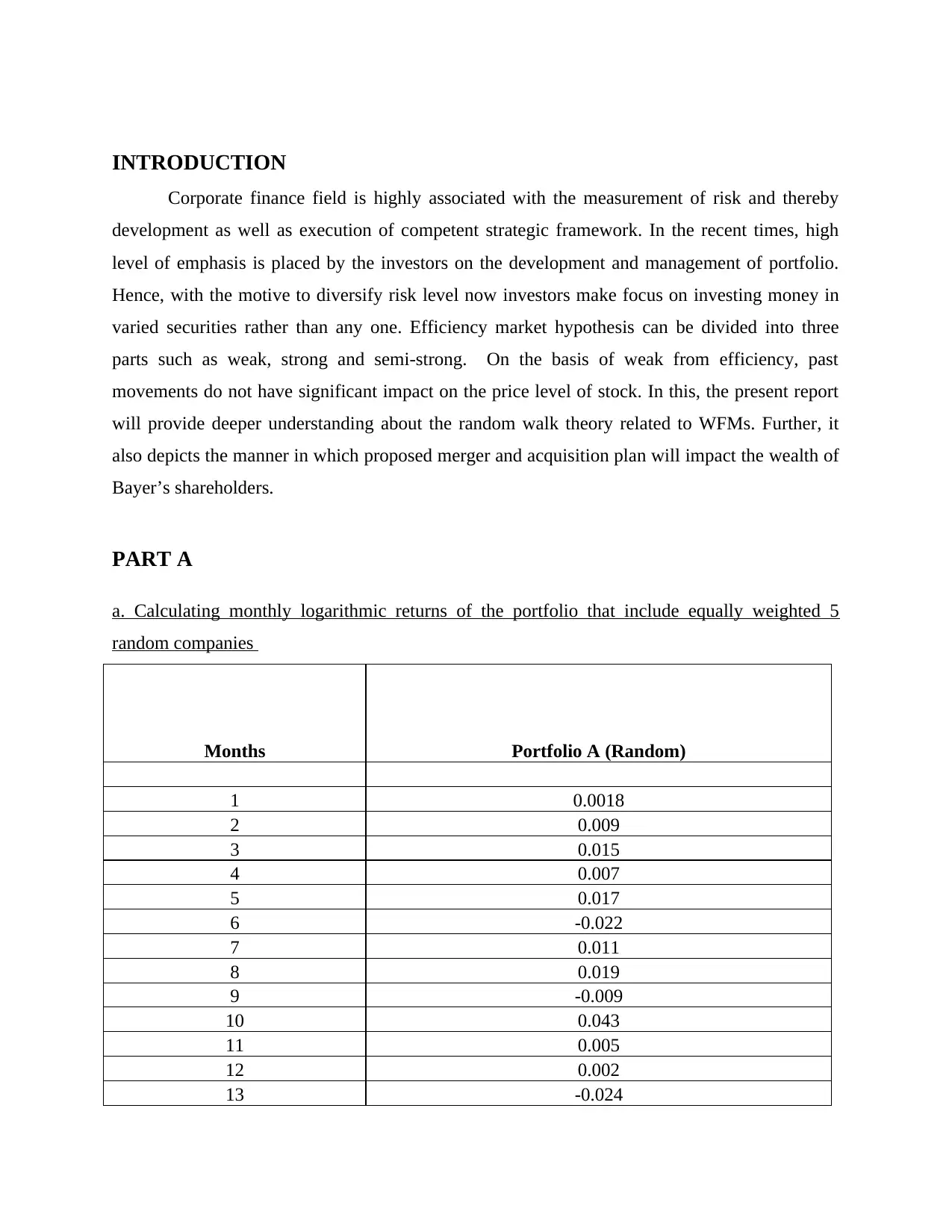
INTRODUCTION
Corporate finance field is highly associated with the measurement of risk and thereby
development as well as execution of competent strategic framework. In the recent times, high
level of emphasis is placed by the investors on the development and management of portfolio.
Hence, with the motive to diversify risk level now investors make focus on investing money in
varied securities rather than any one. Efficiency market hypothesis can be divided into three
parts such as weak, strong and semi-strong. On the basis of weak from efficiency, past
movements do not have significant impact on the price level of stock. In this, the present report
will provide deeper understanding about the random walk theory related to WFMs. Further, it
also depicts the manner in which proposed merger and acquisition plan will impact the wealth of
Bayer’s shareholders.
PART A
a. Calculating monthly logarithmic returns of the portfolio that include equally weighted 5
random companies
Months Portfolio A (Random)
1 0.0018
2 0.009
3 0.015
4 0.007
5 0.017
6 -0.022
7 0.011
8 0.019
9 -0.009
10 0.043
11 0.005
12 0.002
13 -0.024
Corporate finance field is highly associated with the measurement of risk and thereby
development as well as execution of competent strategic framework. In the recent times, high
level of emphasis is placed by the investors on the development and management of portfolio.
Hence, with the motive to diversify risk level now investors make focus on investing money in
varied securities rather than any one. Efficiency market hypothesis can be divided into three
parts such as weak, strong and semi-strong. On the basis of weak from efficiency, past
movements do not have significant impact on the price level of stock. In this, the present report
will provide deeper understanding about the random walk theory related to WFMs. Further, it
also depicts the manner in which proposed merger and acquisition plan will impact the wealth of
Bayer’s shareholders.
PART A
a. Calculating monthly logarithmic returns of the portfolio that include equally weighted 5
random companies
Months Portfolio A (Random)
1 0.0018
2 0.009
3 0.015
4 0.007
5 0.017
6 -0.022
7 0.011
8 0.019
9 -0.009
10 0.043
11 0.005
12 0.002
13 -0.024
⊘ This is a preview!⊘
Do you want full access?
Subscribe today to unlock all pages.

Trusted by 1+ million students worldwide
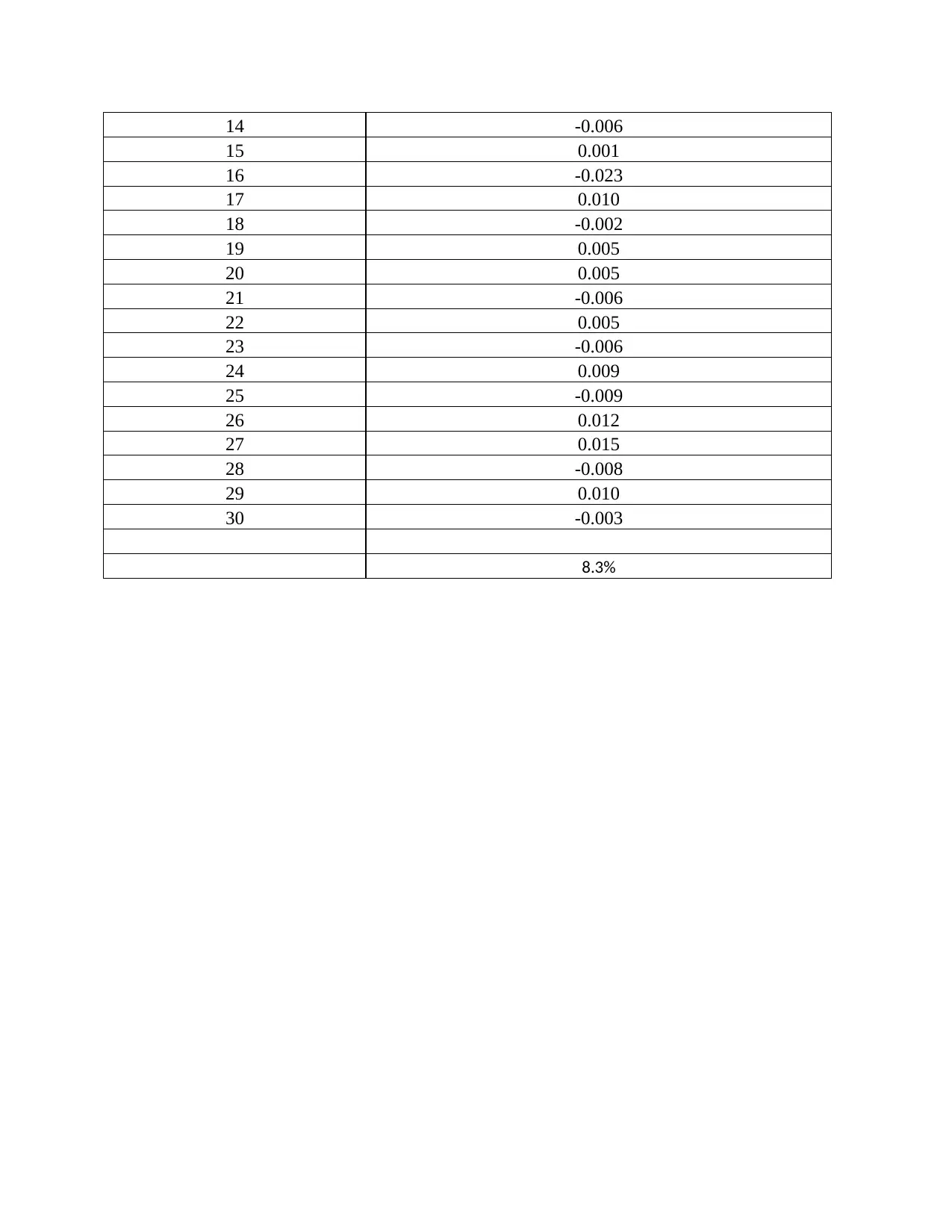
14 -0.006
15 0.001
16 -0.023
17 0.010
18 -0.002
19 0.005
20 0.005
21 -0.006
22 0.005
23 -0.006
24 0.009
25 -0.009
26 0.012
27 0.015
28 -0.008
29 0.010
30 -0.003
8.3%
15 0.001
16 -0.023
17 0.010
18 -0.002
19 0.005
20 0.005
21 -0.006
22 0.005
23 -0.006
24 0.009
25 -0.009
26 0.012
27 0.015
28 -0.008
29 0.010
30 -0.003
8.3%
Paraphrase This Document
Need a fresh take? Get an instant paraphrase of this document with our AI Paraphraser
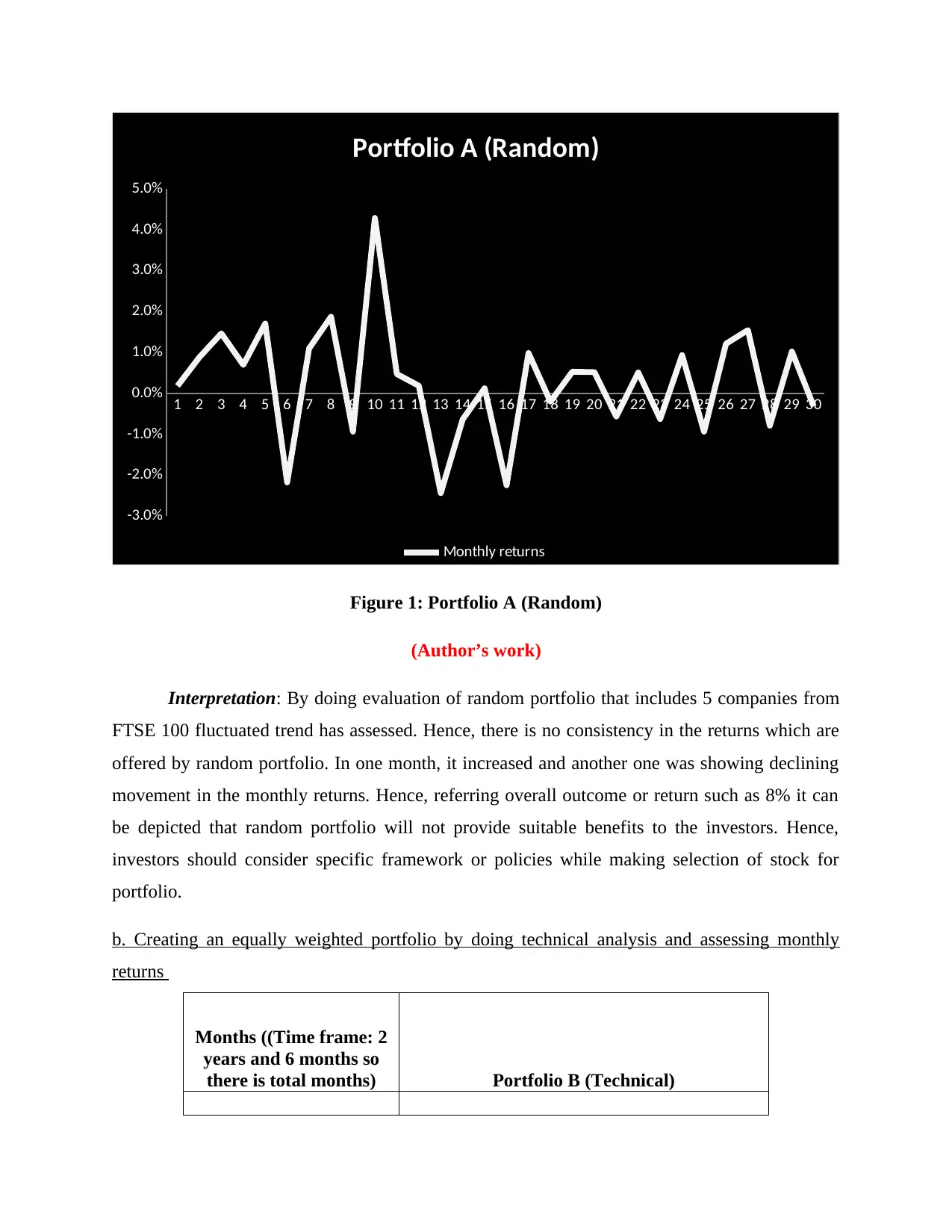
1 2 3 4 5 6 7 8 9 10 11 12 13 14 15 16 17 18 19 20 21 22 23 24 25 26 27 28 29 30
-3.0%
-2.0%
-1.0%
0.0%
1.0%
2.0%
3.0%
4.0%
5.0%
Portfolio A (Random)
Monthly returns
Figure 1: Portfolio A (Random)
(Author’s work)
Interpretation: By doing evaluation of random portfolio that includes 5 companies from
FTSE 100 fluctuated trend has assessed. Hence, there is no consistency in the returns which are
offered by random portfolio. In one month, it increased and another one was showing declining
movement in the monthly returns. Hence, referring overall outcome or return such as 8% it can
be depicted that random portfolio will not provide suitable benefits to the investors. Hence,
investors should consider specific framework or policies while making selection of stock for
portfolio.
b. Creating an equally weighted portfolio by doing technical analysis and assessing monthly
returns
Months ((Time frame: 2
years and 6 months so
there is total months) Portfolio B (Technical)
-3.0%
-2.0%
-1.0%
0.0%
1.0%
2.0%
3.0%
4.0%
5.0%
Portfolio A (Random)
Monthly returns
Figure 1: Portfolio A (Random)
(Author’s work)
Interpretation: By doing evaluation of random portfolio that includes 5 companies from
FTSE 100 fluctuated trend has assessed. Hence, there is no consistency in the returns which are
offered by random portfolio. In one month, it increased and another one was showing declining
movement in the monthly returns. Hence, referring overall outcome or return such as 8% it can
be depicted that random portfolio will not provide suitable benefits to the investors. Hence,
investors should consider specific framework or policies while making selection of stock for
portfolio.
b. Creating an equally weighted portfolio by doing technical analysis and assessing monthly
returns
Months ((Time frame: 2
years and 6 months so
there is total months) Portfolio B (Technical)
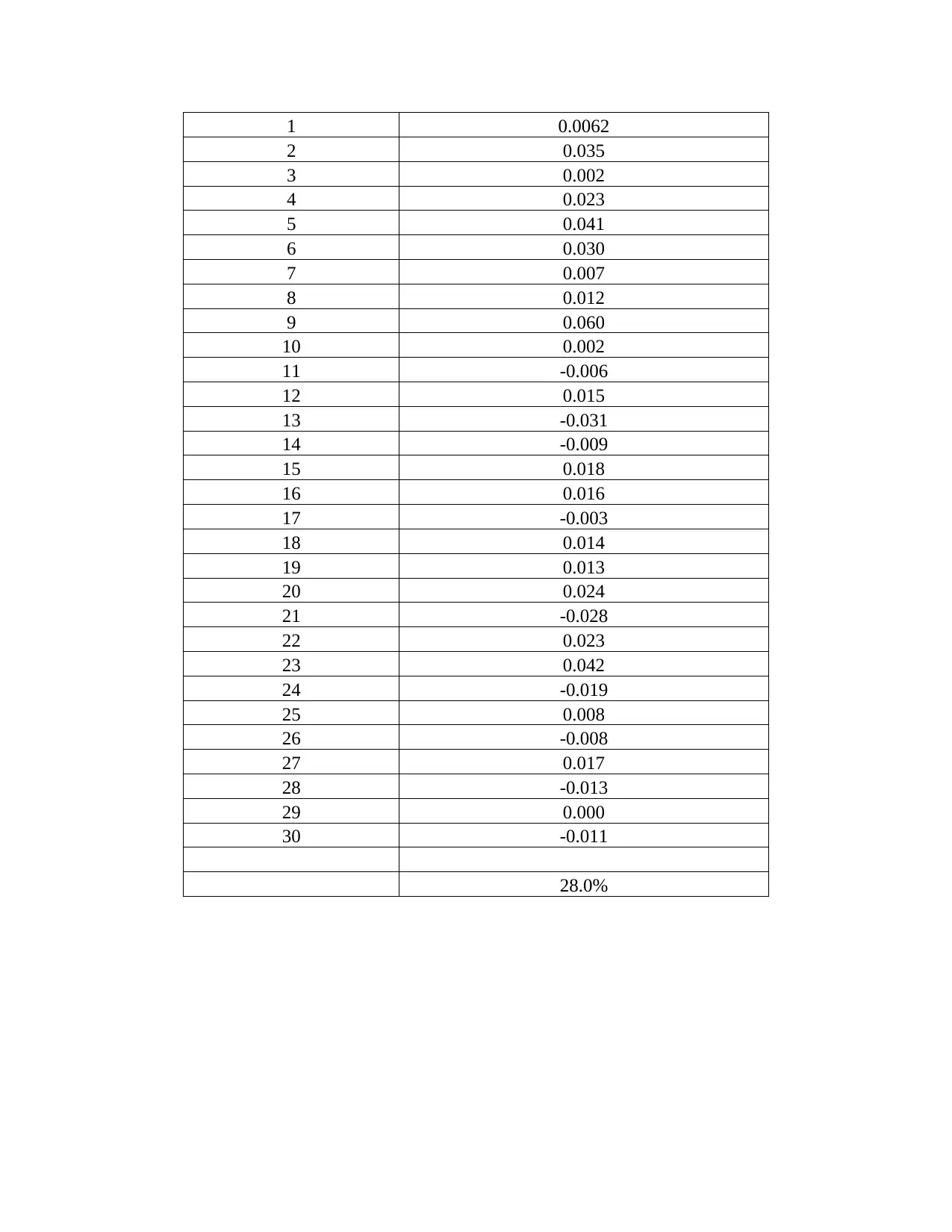
1 0.0062
2 0.035
3 0.002
4 0.023
5 0.041
6 0.030
7 0.007
8 0.012
9 0.060
10 0.002
11 -0.006
12 0.015
13 -0.031
14 -0.009
15 0.018
16 0.016
17 -0.003
18 0.014
19 0.013
20 0.024
21 -0.028
22 0.023
23 0.042
24 -0.019
25 0.008
26 -0.008
27 0.017
28 -0.013
29 0.000
30 -0.011
28.0%
2 0.035
3 0.002
4 0.023
5 0.041
6 0.030
7 0.007
8 0.012
9 0.060
10 0.002
11 -0.006
12 0.015
13 -0.031
14 -0.009
15 0.018
16 0.016
17 -0.003
18 0.014
19 0.013
20 0.024
21 -0.028
22 0.023
23 0.042
24 -0.019
25 0.008
26 -0.008
27 0.017
28 -0.013
29 0.000
30 -0.011
28.0%
⊘ This is a preview!⊘
Do you want full access?
Subscribe today to unlock all pages.

Trusted by 1+ million students worldwide
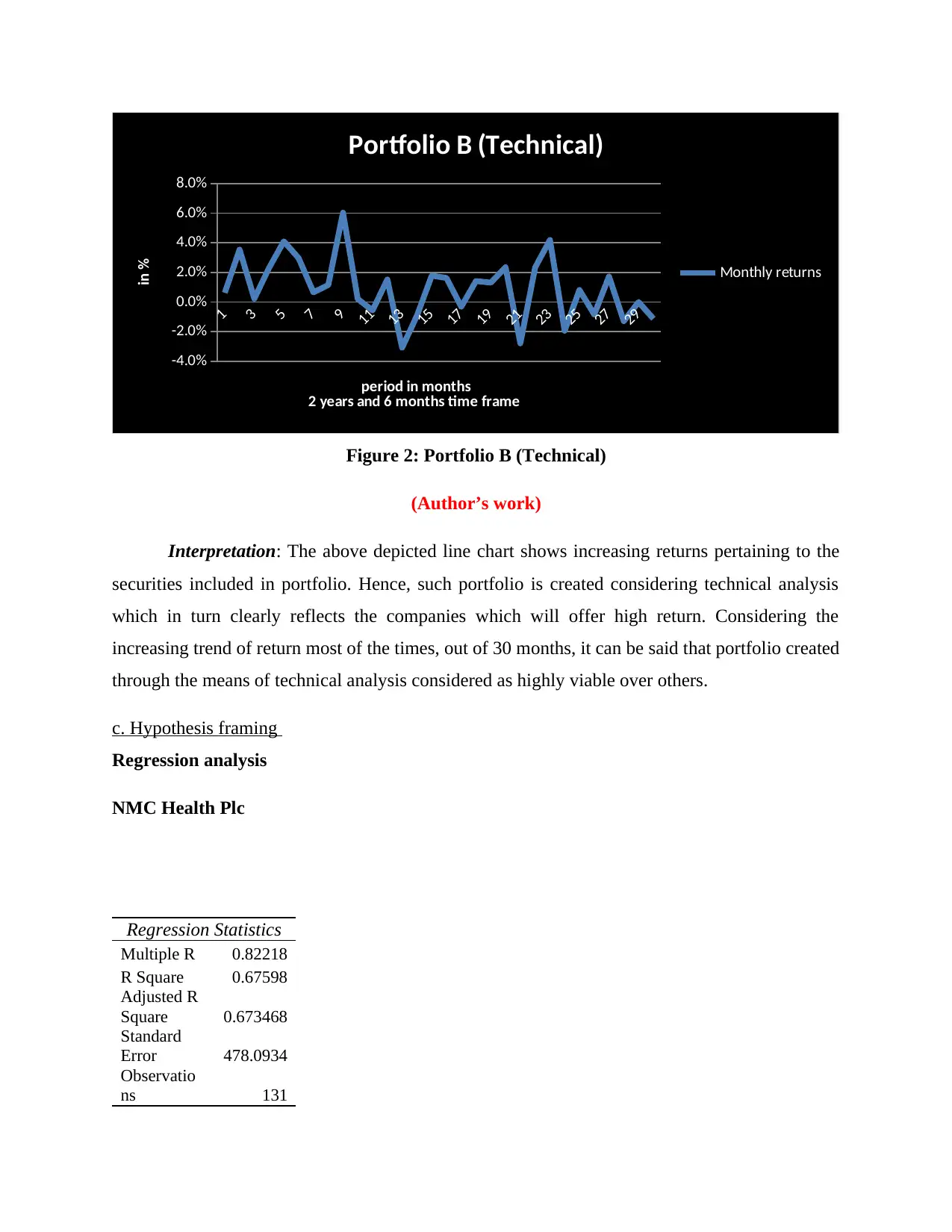
1
3
5
7
9
11
13
15
17
19
21
23
25
27
29
-4.0%
-2.0%
0.0%
2.0%
4.0%
6.0%
8.0%
Portfolio B (Technical)
Monthly returns
period in months
2 years and 6 months time frame
in %
Figure 2: Portfolio B (Technical)
(Author’s work)
Interpretation: The above depicted line chart shows increasing returns pertaining to the
securities included in portfolio. Hence, such portfolio is created considering technical analysis
which in turn clearly reflects the companies which will offer high return. Considering the
increasing trend of return most of the times, out of 30 months, it can be said that portfolio created
through the means of technical analysis considered as highly viable over others.
c. Hypothesis framing
Regression analysis
NMC Health Plc
Regression Statistics
Multiple R 0.82218
R Square 0.67598
Adjusted R
Square 0.673468
Standard
Error 478.0934
Observatio
ns 131
3
5
7
9
11
13
15
17
19
21
23
25
27
29
-4.0%
-2.0%
0.0%
2.0%
4.0%
6.0%
8.0%
Portfolio B (Technical)
Monthly returns
period in months
2 years and 6 months time frame
in %
Figure 2: Portfolio B (Technical)
(Author’s work)
Interpretation: The above depicted line chart shows increasing returns pertaining to the
securities included in portfolio. Hence, such portfolio is created considering technical analysis
which in turn clearly reflects the companies which will offer high return. Considering the
increasing trend of return most of the times, out of 30 months, it can be said that portfolio created
through the means of technical analysis considered as highly viable over others.
c. Hypothesis framing
Regression analysis
NMC Health Plc
Regression Statistics
Multiple R 0.82218
R Square 0.67598
Adjusted R
Square 0.673468
Standard
Error 478.0934
Observatio
ns 131
Paraphrase This Document
Need a fresh take? Get an instant paraphrase of this document with our AI Paraphraser
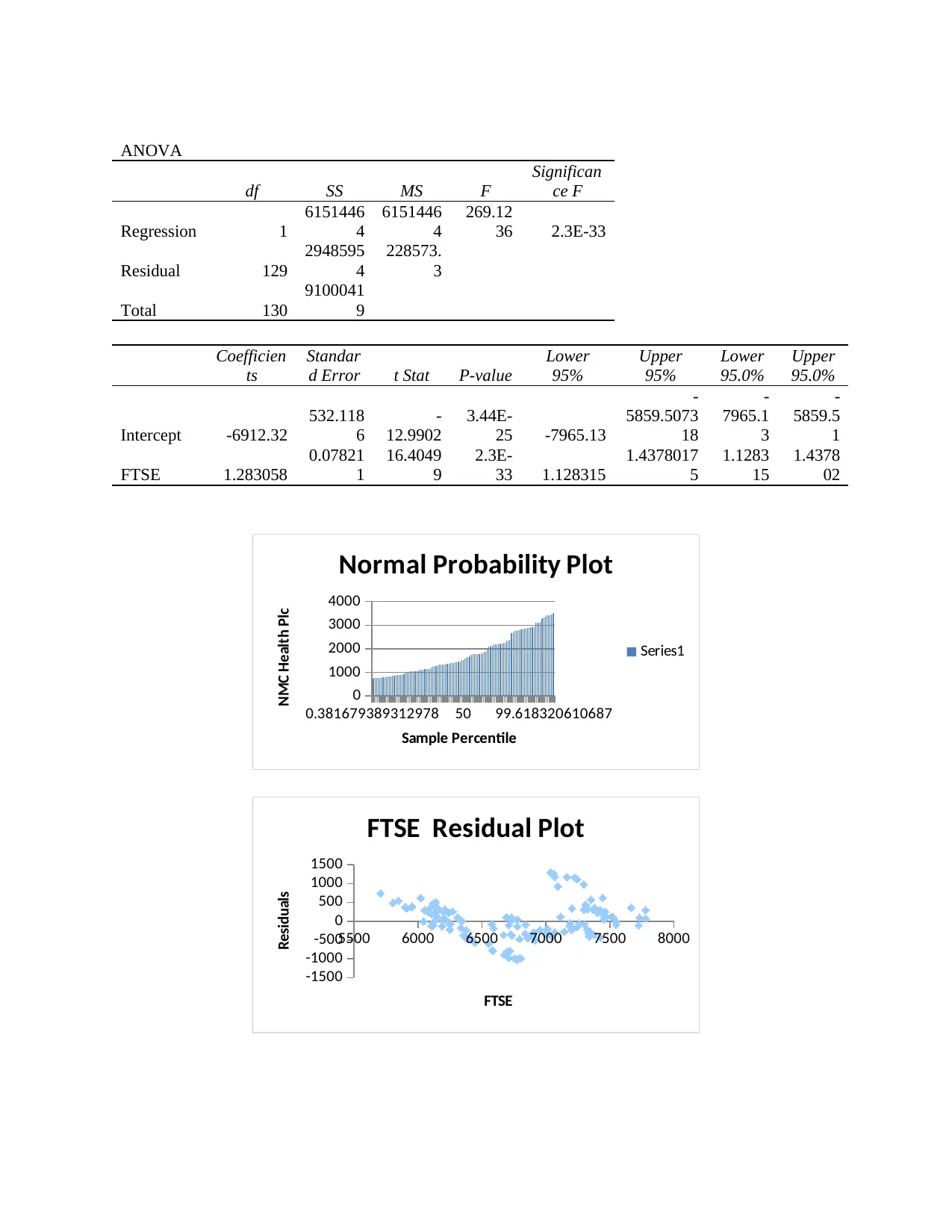
ANOVA
df SS MS F
Significan
ce F
Regression 1
6151446
4
6151446
4
269.12
36 2.3E-33
Residual 129
2948595
4
228573.
3
Total 130
9100041
9
Coefficien
ts
Standar
d Error t Stat P-value
Lower
95%
Upper
95%
Lower
95.0%
Upper
95.0%
Intercept -6912.32
532.118
6
-
12.9902
3.44E-
25 -7965.13
-
5859.5073
18
-
7965.1
3
-
5859.5
1
FTSE 1.283058
0.07821
1
16.4049
9
2.3E-
33 1.128315
1.4378017
5
1.1283
15
1.4378
02
0.381679389312978 50 99.618320610687
0
1000
2000
3000
4000
Normal Probability Plot
Series1
Sample Percentile
NMC Health Plc
5500 6000 6500 7000 7500 8000
-1500
-1000
-500
0
500
1000
1500
FTSE Residual Plot
FTSE
Residuals
df SS MS F
Significan
ce F
Regression 1
6151446
4
6151446
4
269.12
36 2.3E-33
Residual 129
2948595
4
228573.
3
Total 130
9100041
9
Coefficien
ts
Standar
d Error t Stat P-value
Lower
95%
Upper
95%
Lower
95.0%
Upper
95.0%
Intercept -6912.32
532.118
6
-
12.9902
3.44E-
25 -7965.13
-
5859.5073
18
-
7965.1
3
-
5859.5
1
FTSE 1.283058
0.07821
1
16.4049
9
2.3E-
33 1.128315
1.4378017
5
1.1283
15
1.4378
02
0.381679389312978 50 99.618320610687
0
1000
2000
3000
4000
Normal Probability Plot
Series1
Sample Percentile
NMC Health Plc
5500 6000 6500 7000 7500 8000
-1500
-1000
-500
0
500
1000
1500
FTSE Residual Plot
FTSE
Residuals
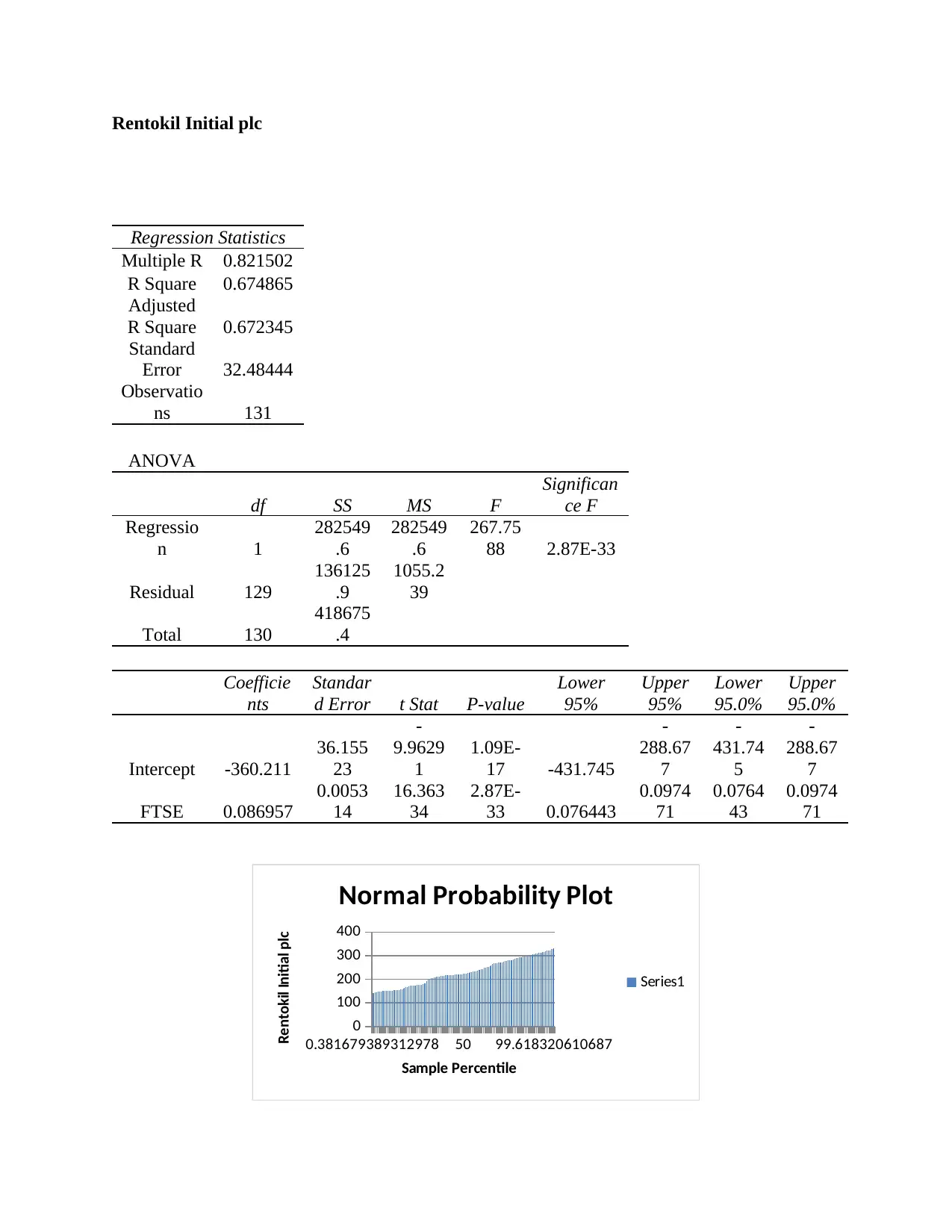
Rentokil Initial plc
Regression Statistics
Multiple R 0.821502
R Square 0.674865
Adjusted
R Square 0.672345
Standard
Error 32.48444
Observatio
ns 131
ANOVA
df SS MS F
Significan
ce F
Regressio
n 1
282549
.6
282549
.6
267.75
88 2.87E-33
Residual 129
136125
.9
1055.2
39
Total 130
418675
.4
Coefficie
nts
Standar
d Error t Stat P-value
Lower
95%
Upper
95%
Lower
95.0%
Upper
95.0%
Intercept -360.211
36.155
23
-
9.9629
1
1.09E-
17 -431.745
-
288.67
7
-
431.74
5
-
288.67
7
FTSE 0.086957
0.0053
14
16.363
34
2.87E-
33 0.076443
0.0974
71
0.0764
43
0.0974
71
0.381679389312978 50 99.618320610687
0
100
200
300
400
Normal Probability Plot
Series1
Sample Percentile
Rentokil Initial plc
Regression Statistics
Multiple R 0.821502
R Square 0.674865
Adjusted
R Square 0.672345
Standard
Error 32.48444
Observatio
ns 131
ANOVA
df SS MS F
Significan
ce F
Regressio
n 1
282549
.6
282549
.6
267.75
88 2.87E-33
Residual 129
136125
.9
1055.2
39
Total 130
418675
.4
Coefficie
nts
Standar
d Error t Stat P-value
Lower
95%
Upper
95%
Lower
95.0%
Upper
95.0%
Intercept -360.211
36.155
23
-
9.9629
1
1.09E-
17 -431.745
-
288.67
7
-
431.74
5
-
288.67
7
FTSE 0.086957
0.0053
14
16.363
34
2.87E-
33 0.076443
0.0974
71
0.0764
43
0.0974
71
0.381679389312978 50 99.618320610687
0
100
200
300
400
Normal Probability Plot
Series1
Sample Percentile
Rentokil Initial plc
⊘ This is a preview!⊘
Do you want full access?
Subscribe today to unlock all pages.

Trusted by 1+ million students worldwide

5500 6000 6500 7000 7500 8000
-100
-50
0
50
100
FTSE Residual Plot
FTSE
Residuals
Intertek Group plc
Regression Statistics
Multiple R 0.789156
R Square 0.622767
Adjusted
R Square 0.619842
Standard
Error 552.5551
Observati
ons 131
ANOVA
df SS MS F
Significan
ce F
Regressio
n 1
650213
85
650213
85
212.96
34 4.35E-29
Residual 129
393859
10
305317.
1
Total 130
1.04E+
08
Coefficie
nts
Standar
d Error t Stat P-value
Lower
95%
Upper
95%
Lower
95.0%
Upper
95.0%
Intercept -5157.66 614.994
5
-
8.38651
7.52E-
14
-6374.44 -
3940.8
-
6374.4
-
3940.8
-100
-50
0
50
100
FTSE Residual Plot
FTSE
Residuals
Intertek Group plc
Regression Statistics
Multiple R 0.789156
R Square 0.622767
Adjusted
R Square 0.619842
Standard
Error 552.5551
Observati
ons 131
ANOVA
df SS MS F
Significan
ce F
Regressio
n 1
650213
85
650213
85
212.96
34 4.35E-29
Residual 129
393859
10
305317.
1
Total 130
1.04E+
08
Coefficie
nts
Standar
d Error t Stat P-value
Lower
95%
Upper
95%
Lower
95.0%
Upper
95.0%
Intercept -5157.66 614.994
5
-
8.38651
7.52E-
14
-6374.44 -
3940.8
-
6374.4
-
3940.8
Paraphrase This Document
Need a fresh take? Get an instant paraphrase of this document with our AI Paraphraser
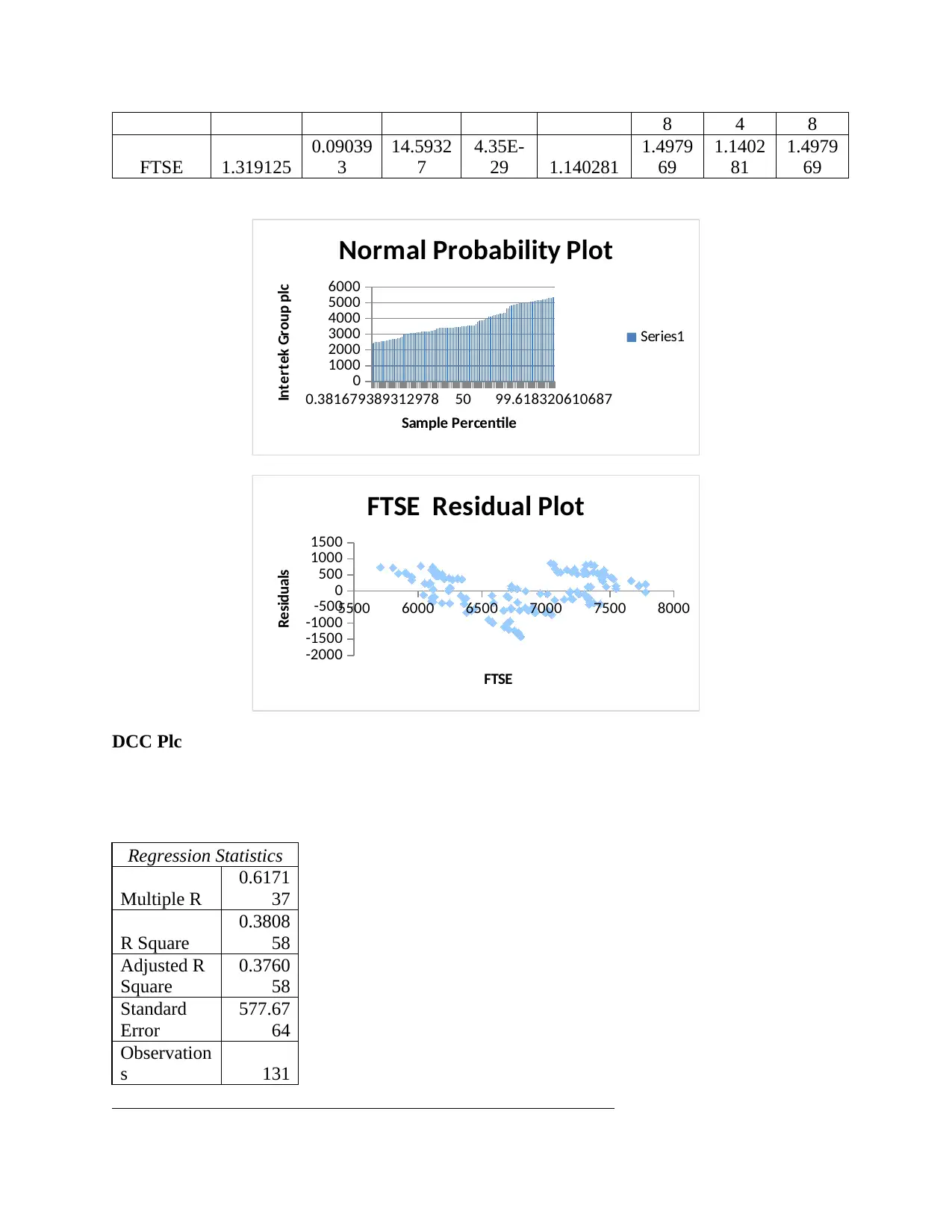
8 4 8
FTSE 1.319125
0.09039
3
14.5932
7
4.35E-
29 1.140281
1.4979
69
1.1402
81
1.4979
69
0.381679389312978 50 99.618320610687
0
1000
2000
3000
4000
5000
6000
Normal Probability Plot
Series1
Sample Percentile
Intertek Group plc
5500 6000 6500 7000 7500 8000
-2000
-1500
-1000
-500
0
500
1000
1500
FTSE Residual Plot
FTSE
Residuals
DCC Plc
Regression Statistics
Multiple R
0.6171
37
R Square
0.3808
58
Adjusted R
Square
0.3760
58
Standard
Error
577.67
64
Observation
s 131
FTSE 1.319125
0.09039
3
14.5932
7
4.35E-
29 1.140281
1.4979
69
1.1402
81
1.4979
69
0.381679389312978 50 99.618320610687
0
1000
2000
3000
4000
5000
6000
Normal Probability Plot
Series1
Sample Percentile
Intertek Group plc
5500 6000 6500 7000 7500 8000
-2000
-1500
-1000
-500
0
500
1000
1500
FTSE Residual Plot
FTSE
Residuals
DCC Plc
Regression Statistics
Multiple R
0.6171
37
R Square
0.3808
58
Adjusted R
Square
0.3760
58
Standard
Error
577.67
64
Observation
s 131
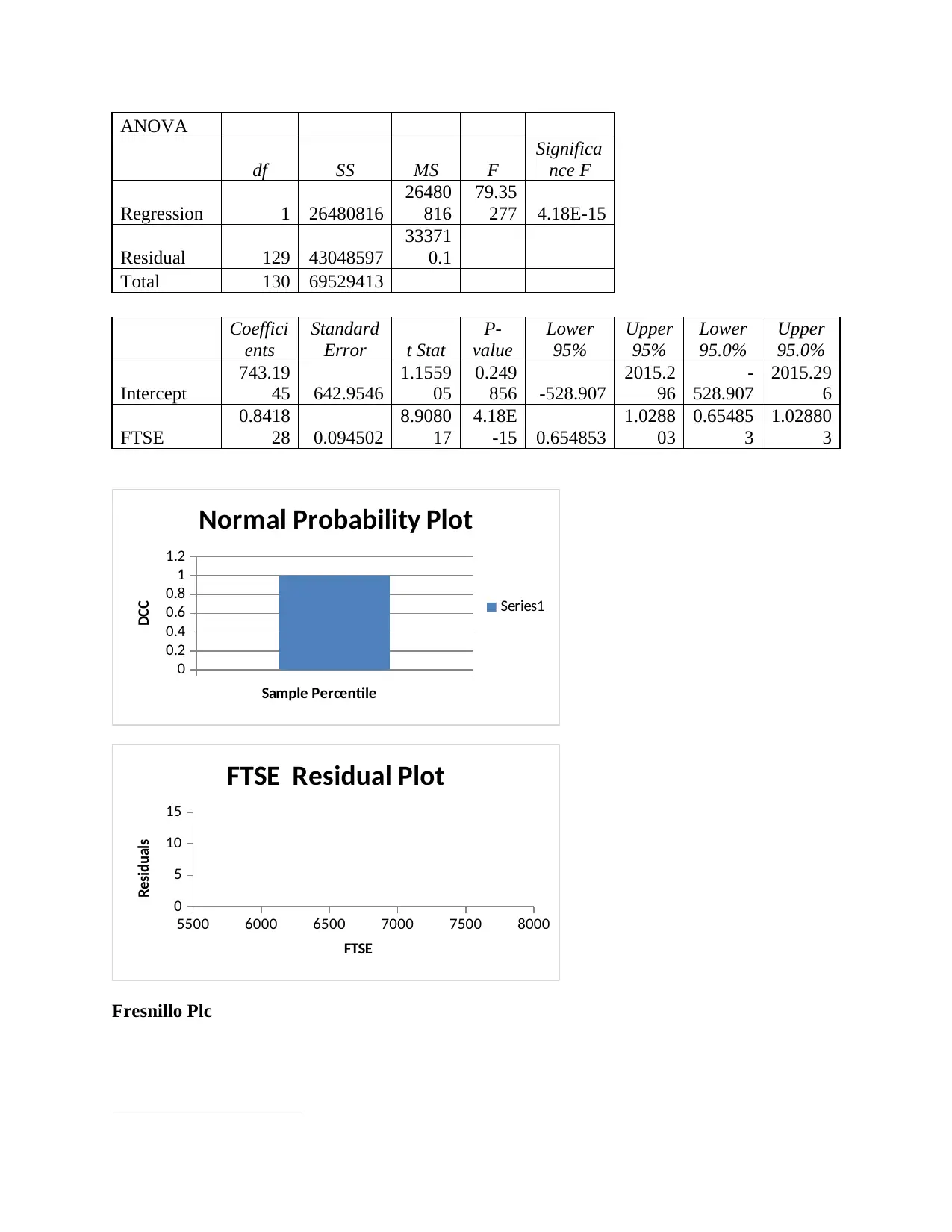
ANOVA
df SS MS F
Significa
nce F
Regression 1 26480816
26480
816
79.35
277 4.18E-15
Residual 129 43048597
33371
0.1
Total 130 69529413
Coeffici
ents
Standard
Error t Stat
P-
value
Lower
95%
Upper
95%
Lower
95.0%
Upper
95.0%
Intercept
743.19
45 642.9546
1.1559
05
0.249
856 -528.907
2015.2
96
-
528.907
2015.29
6
FTSE
0.8418
28 0.094502
8.9080
17
4.18E
-15 0.654853
1.0288
03
0.65485
3
1.02880
3
0
0.2
0.4
0.6
0.8
1
1.2
Normal Probability Plot
Series1
Sample Percentile
DCC
5500 6000 6500 7000 7500 8000
0
5
10
15
FTSE Residual Plot
FTSE
Residuals
Fresnillo Plc
df SS MS F
Significa
nce F
Regression 1 26480816
26480
816
79.35
277 4.18E-15
Residual 129 43048597
33371
0.1
Total 130 69529413
Coeffici
ents
Standard
Error t Stat
P-
value
Lower
95%
Upper
95%
Lower
95.0%
Upper
95.0%
Intercept
743.19
45 642.9546
1.1559
05
0.249
856 -528.907
2015.2
96
-
528.907
2015.29
6
FTSE
0.8418
28 0.094502
8.9080
17
4.18E
-15 0.654853
1.0288
03
0.65485
3
1.02880
3
0
0.2
0.4
0.6
0.8
1
1.2
Normal Probability Plot
Series1
Sample Percentile
DCC
5500 6000 6500 7000 7500 8000
0
5
10
15
FTSE Residual Plot
FTSE
Residuals
Fresnillo Plc
⊘ This is a preview!⊘
Do you want full access?
Subscribe today to unlock all pages.

Trusted by 1+ million students worldwide
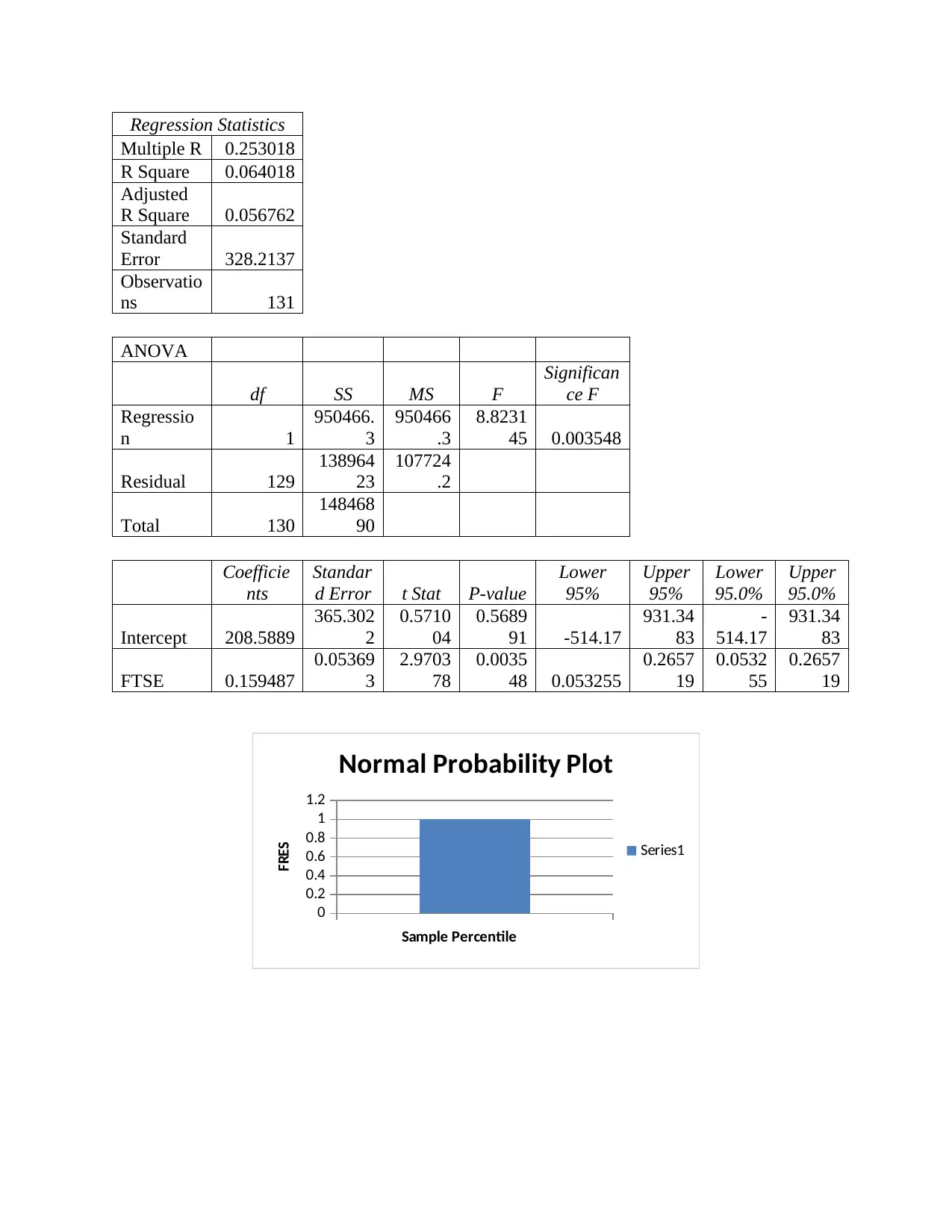
Regression Statistics
Multiple R 0.253018
R Square 0.064018
Adjusted
R Square 0.056762
Standard
Error 328.2137
Observatio
ns 131
ANOVA
df SS MS F
Significan
ce F
Regressio
n 1
950466.
3
950466
.3
8.8231
45 0.003548
Residual 129
138964
23
107724
.2
Total 130
148468
90
Coefficie
nts
Standar
d Error t Stat P-value
Lower
95%
Upper
95%
Lower
95.0%
Upper
95.0%
Intercept 208.5889
365.302
2
0.5710
04
0.5689
91 -514.17
931.34
83
-
514.17
931.34
83
FTSE 0.159487
0.05369
3
2.9703
78
0.0035
48 0.053255
0.2657
19
0.0532
55
0.2657
19
0
0.2
0.4
0.6
0.8
1
1.2
Normal Probability Plot
Series1
Sample Percentile
FRES
Multiple R 0.253018
R Square 0.064018
Adjusted
R Square 0.056762
Standard
Error 328.2137
Observatio
ns 131
ANOVA
df SS MS F
Significan
ce F
Regressio
n 1
950466.
3
950466
.3
8.8231
45 0.003548
Residual 129
138964
23
107724
.2
Total 130
148468
90
Coefficie
nts
Standar
d Error t Stat P-value
Lower
95%
Upper
95%
Lower
95.0%
Upper
95.0%
Intercept 208.5889
365.302
2
0.5710
04
0.5689
91 -514.17
931.34
83
-
514.17
931.34
83
FTSE 0.159487
0.05369
3
2.9703
78
0.0035
48 0.053255
0.2657
19
0.0532
55
0.2657
19
0
0.2
0.4
0.6
0.8
1
1.2
Normal Probability Plot
Series1
Sample Percentile
FRES
Paraphrase This Document
Need a fresh take? Get an instant paraphrase of this document with our AI Paraphraser

5500 6000 6500 7000 7500 8000
0
5
10
15
FTSE Residual Plot
FTSE
Residuals
d. Testing monthly logarithmic returns of both the portfolios by taking into account independent
sample t- test
Hypothesis
H0 (Null hypothesis): There is no significant mean difference in the return generated by
portfolio A and portfolio B.
H1 (Alternative hypothesis): There is no significant mean difference in the return generated by
portfolio A and portfolio B.
Independent sample t test
Portfolio A
(Random)
Portfolio B
(Technical)
Mean 0.002772 0.009324
Variance 0.000188 0.000435
Observations 30 30
Pooled Variance 0.000311
Hypothesized Mean Difference 0
df 58
t Stat -1.43809
P(T<=t) one-tail 0.077892
t Critical one-tail 1.671553
P(T<=t) two-tail 0.155784
t Critical two-tail 2.001717
Outcome of t test evaluation shows that p>0.05 which shows that null hypothesis is true
and other one is rejected. Referring this, it can be stated that no statistical significant difference
0
5
10
15
FTSE Residual Plot
FTSE
Residuals
d. Testing monthly logarithmic returns of both the portfolios by taking into account independent
sample t- test
Hypothesis
H0 (Null hypothesis): There is no significant mean difference in the return generated by
portfolio A and portfolio B.
H1 (Alternative hypothesis): There is no significant mean difference in the return generated by
portfolio A and portfolio B.
Independent sample t test
Portfolio A
(Random)
Portfolio B
(Technical)
Mean 0.002772 0.009324
Variance 0.000188 0.000435
Observations 30 30
Pooled Variance 0.000311
Hypothesized Mean Difference 0
df 58
t Stat -1.43809
P(T<=t) one-tail 0.077892
t Critical one-tail 1.671553
P(T<=t) two-tail 0.155784
t Critical two-tail 2.001717
Outcome of t test evaluation shows that p>0.05 which shows that null hypothesis is true
and other one is rejected. Referring this, it can be stated that no statistical significant difference
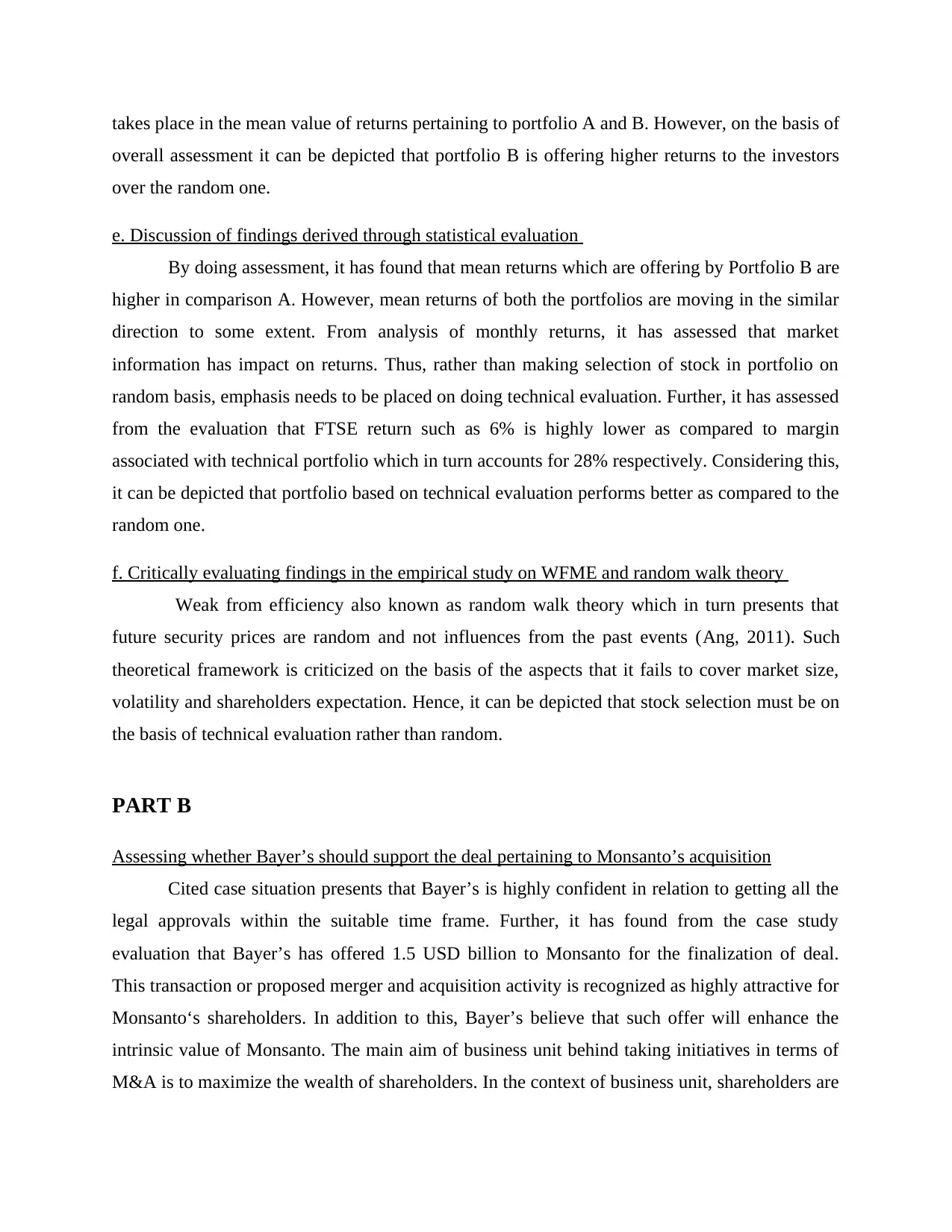
takes place in the mean value of returns pertaining to portfolio A and B. However, on the basis of
overall assessment it can be depicted that portfolio B is offering higher returns to the investors
over the random one.
e. Discussion of findings derived through statistical evaluation
By doing assessment, it has found that mean returns which are offering by Portfolio B are
higher in comparison A. However, mean returns of both the portfolios are moving in the similar
direction to some extent. From analysis of monthly returns, it has assessed that market
information has impact on returns. Thus, rather than making selection of stock in portfolio on
random basis, emphasis needs to be placed on doing technical evaluation. Further, it has assessed
from the evaluation that FTSE return such as 6% is highly lower as compared to margin
associated with technical portfolio which in turn accounts for 28% respectively. Considering this,
it can be depicted that portfolio based on technical evaluation performs better as compared to the
random one.
f. Critically evaluating findings in the empirical study on WFME and random walk theory
Weak from efficiency also known as random walk theory which in turn presents that
future security prices are random and not influences from the past events (Ang, 2011). Such
theoretical framework is criticized on the basis of the aspects that it fails to cover market size,
volatility and shareholders expectation. Hence, it can be depicted that stock selection must be on
the basis of technical evaluation rather than random.
PART B
Assessing whether Bayer’s should support the deal pertaining to Monsanto’s acquisition
Cited case situation presents that Bayer’s is highly confident in relation to getting all the
legal approvals within the suitable time frame. Further, it has found from the case study
evaluation that Bayer’s has offered 1.5 USD billion to Monsanto for the finalization of deal.
This transaction or proposed merger and acquisition activity is recognized as highly attractive for
Monsanto‘s shareholders. In addition to this, Bayer’s believe that such offer will enhance the
intrinsic value of Monsanto. The main aim of business unit behind taking initiatives in terms of
M&A is to maximize the wealth of shareholders. In the context of business unit, shareholders are
overall assessment it can be depicted that portfolio B is offering higher returns to the investors
over the random one.
e. Discussion of findings derived through statistical evaluation
By doing assessment, it has found that mean returns which are offering by Portfolio B are
higher in comparison A. However, mean returns of both the portfolios are moving in the similar
direction to some extent. From analysis of monthly returns, it has assessed that market
information has impact on returns. Thus, rather than making selection of stock in portfolio on
random basis, emphasis needs to be placed on doing technical evaluation. Further, it has assessed
from the evaluation that FTSE return such as 6% is highly lower as compared to margin
associated with technical portfolio which in turn accounts for 28% respectively. Considering this,
it can be depicted that portfolio based on technical evaluation performs better as compared to the
random one.
f. Critically evaluating findings in the empirical study on WFME and random walk theory
Weak from efficiency also known as random walk theory which in turn presents that
future security prices are random and not influences from the past events (Ang, 2011). Such
theoretical framework is criticized on the basis of the aspects that it fails to cover market size,
volatility and shareholders expectation. Hence, it can be depicted that stock selection must be on
the basis of technical evaluation rather than random.
PART B
Assessing whether Bayer’s should support the deal pertaining to Monsanto’s acquisition
Cited case situation presents that Bayer’s is highly confident in relation to getting all the
legal approvals within the suitable time frame. Further, it has found from the case study
evaluation that Bayer’s has offered 1.5 USD billion to Monsanto for the finalization of deal.
This transaction or proposed merger and acquisition activity is recognized as highly attractive for
Monsanto‘s shareholders. In addition to this, Bayer’s believe that such offer will enhance the
intrinsic value of Monsanto. The main aim of business unit behind taking initiatives in terms of
M&A is to maximize the wealth of shareholders. In the context of business unit, shareholders are
⊘ This is a preview!⊘
Do you want full access?
Subscribe today to unlock all pages.

Trusted by 1+ million students worldwide
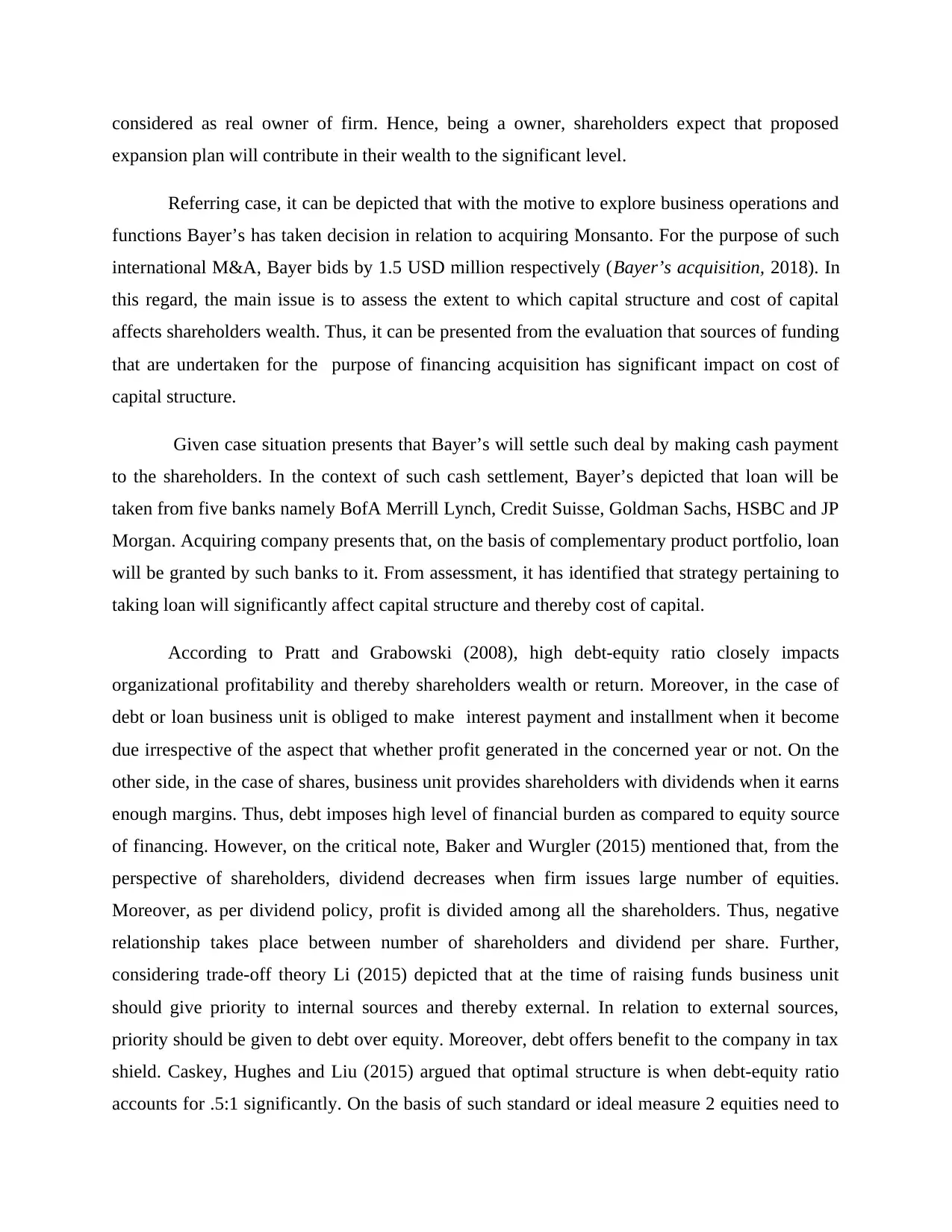
considered as real owner of firm. Hence, being a owner, shareholders expect that proposed
expansion plan will contribute in their wealth to the significant level.
Referring case, it can be depicted that with the motive to explore business operations and
functions Bayer’s has taken decision in relation to acquiring Monsanto. For the purpose of such
international M&A, Bayer bids by 1.5 USD million respectively (Bayer’s acquisition, 2018). In
this regard, the main issue is to assess the extent to which capital structure and cost of capital
affects shareholders wealth. Thus, it can be presented from the evaluation that sources of funding
that are undertaken for the purpose of financing acquisition has significant impact on cost of
capital structure.
Given case situation presents that Bayer’s will settle such deal by making cash payment
to the shareholders. In the context of such cash settlement, Bayer’s depicted that loan will be
taken from five banks namely BofA Merrill Lynch, Credit Suisse, Goldman Sachs, HSBC and JP
Morgan. Acquiring company presents that, on the basis of complementary product portfolio, loan
will be granted by such banks to it. From assessment, it has identified that strategy pertaining to
taking loan will significantly affect capital structure and thereby cost of capital.
According to Pratt and Grabowski (2008), high debt-equity ratio closely impacts
organizational profitability and thereby shareholders wealth or return. Moreover, in the case of
debt or loan business unit is obliged to make interest payment and installment when it become
due irrespective of the aspect that whether profit generated in the concerned year or not. On the
other side, in the case of shares, business unit provides shareholders with dividends when it earns
enough margins. Thus, debt imposes high level of financial burden as compared to equity source
of financing. However, on the critical note, Baker and Wurgler (2015) mentioned that, from the
perspective of shareholders, dividend decreases when firm issues large number of equities.
Moreover, as per dividend policy, profit is divided among all the shareholders. Thus, negative
relationship takes place between number of shareholders and dividend per share. Further,
considering trade-off theory Li (2015) depicted that at the time of raising funds business unit
should give priority to internal sources and thereby external. In relation to external sources,
priority should be given to debt over equity. Moreover, debt offers benefit to the company in tax
shield. Caskey, Hughes and Liu (2015) argued that optimal structure is when debt-equity ratio
accounts for .5:1 significantly. On the basis of such standard or ideal measure 2 equities need to
expansion plan will contribute in their wealth to the significant level.
Referring case, it can be depicted that with the motive to explore business operations and
functions Bayer’s has taken decision in relation to acquiring Monsanto. For the purpose of such
international M&A, Bayer bids by 1.5 USD million respectively (Bayer’s acquisition, 2018). In
this regard, the main issue is to assess the extent to which capital structure and cost of capital
affects shareholders wealth. Thus, it can be presented from the evaluation that sources of funding
that are undertaken for the purpose of financing acquisition has significant impact on cost of
capital structure.
Given case situation presents that Bayer’s will settle such deal by making cash payment
to the shareholders. In the context of such cash settlement, Bayer’s depicted that loan will be
taken from five banks namely BofA Merrill Lynch, Credit Suisse, Goldman Sachs, HSBC and JP
Morgan. Acquiring company presents that, on the basis of complementary product portfolio, loan
will be granted by such banks to it. From assessment, it has identified that strategy pertaining to
taking loan will significantly affect capital structure and thereby cost of capital.
According to Pratt and Grabowski (2008), high debt-equity ratio closely impacts
organizational profitability and thereby shareholders wealth or return. Moreover, in the case of
debt or loan business unit is obliged to make interest payment and installment when it become
due irrespective of the aspect that whether profit generated in the concerned year or not. On the
other side, in the case of shares, business unit provides shareholders with dividends when it earns
enough margins. Thus, debt imposes high level of financial burden as compared to equity source
of financing. However, on the critical note, Baker and Wurgler (2015) mentioned that, from the
perspective of shareholders, dividend decreases when firm issues large number of equities.
Moreover, as per dividend policy, profit is divided among all the shareholders. Thus, negative
relationship takes place between number of shareholders and dividend per share. Further,
considering trade-off theory Li (2015) depicted that at the time of raising funds business unit
should give priority to internal sources and thereby external. In relation to external sources,
priority should be given to debt over equity. Moreover, debt offers benefit to the company in tax
shield. Caskey, Hughes and Liu (2015) argued that optimal structure is when debt-equity ratio
accounts for .5:1 significantly. On the basis of such standard or ideal measure 2 equities need to
Paraphrase This Document
Need a fresh take? Get an instant paraphrase of this document with our AI Paraphraser
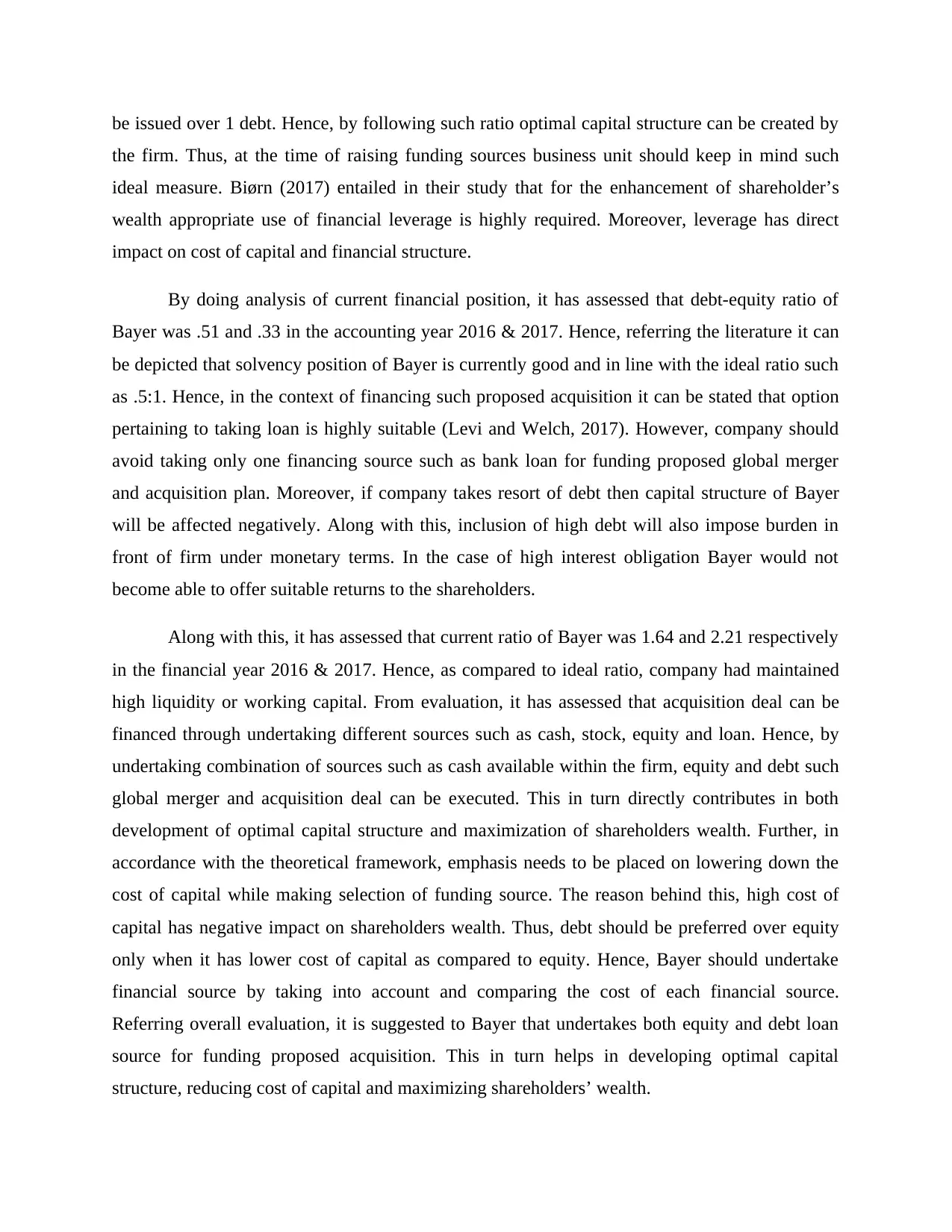
be issued over 1 debt. Hence, by following such ratio optimal capital structure can be created by
the firm. Thus, at the time of raising funding sources business unit should keep in mind such
ideal measure. Biørn (2017) entailed in their study that for the enhancement of shareholder’s
wealth appropriate use of financial leverage is highly required. Moreover, leverage has direct
impact on cost of capital and financial structure.
By doing analysis of current financial position, it has assessed that debt-equity ratio of
Bayer was .51 and .33 in the accounting year 2016 & 2017. Hence, referring the literature it can
be depicted that solvency position of Bayer is currently good and in line with the ideal ratio such
as .5:1. Hence, in the context of financing such proposed acquisition it can be stated that option
pertaining to taking loan is highly suitable (Levi and Welch, 2017). However, company should
avoid taking only one financing source such as bank loan for funding proposed global merger
and acquisition plan. Moreover, if company takes resort of debt then capital structure of Bayer
will be affected negatively. Along with this, inclusion of high debt will also impose burden in
front of firm under monetary terms. In the case of high interest obligation Bayer would not
become able to offer suitable returns to the shareholders.
Along with this, it has assessed that current ratio of Bayer was 1.64 and 2.21 respectively
in the financial year 2016 & 2017. Hence, as compared to ideal ratio, company had maintained
high liquidity or working capital. From evaluation, it has assessed that acquisition deal can be
financed through undertaking different sources such as cash, stock, equity and loan. Hence, by
undertaking combination of sources such as cash available within the firm, equity and debt such
global merger and acquisition deal can be executed. This in turn directly contributes in both
development of optimal capital structure and maximization of shareholders wealth. Further, in
accordance with the theoretical framework, emphasis needs to be placed on lowering down the
cost of capital while making selection of funding source. The reason behind this, high cost of
capital has negative impact on shareholders wealth. Thus, debt should be preferred over equity
only when it has lower cost of capital as compared to equity. Hence, Bayer should undertake
financial source by taking into account and comparing the cost of each financial source.
Referring overall evaluation, it is suggested to Bayer that undertakes both equity and debt loan
source for funding proposed acquisition. This in turn helps in developing optimal capital
structure, reducing cost of capital and maximizing shareholders’ wealth.
the firm. Thus, at the time of raising funding sources business unit should keep in mind such
ideal measure. Biørn (2017) entailed in their study that for the enhancement of shareholder’s
wealth appropriate use of financial leverage is highly required. Moreover, leverage has direct
impact on cost of capital and financial structure.
By doing analysis of current financial position, it has assessed that debt-equity ratio of
Bayer was .51 and .33 in the accounting year 2016 & 2017. Hence, referring the literature it can
be depicted that solvency position of Bayer is currently good and in line with the ideal ratio such
as .5:1. Hence, in the context of financing such proposed acquisition it can be stated that option
pertaining to taking loan is highly suitable (Levi and Welch, 2017). However, company should
avoid taking only one financing source such as bank loan for funding proposed global merger
and acquisition plan. Moreover, if company takes resort of debt then capital structure of Bayer
will be affected negatively. Along with this, inclusion of high debt will also impose burden in
front of firm under monetary terms. In the case of high interest obligation Bayer would not
become able to offer suitable returns to the shareholders.
Along with this, it has assessed that current ratio of Bayer was 1.64 and 2.21 respectively
in the financial year 2016 & 2017. Hence, as compared to ideal ratio, company had maintained
high liquidity or working capital. From evaluation, it has assessed that acquisition deal can be
financed through undertaking different sources such as cash, stock, equity and loan. Hence, by
undertaking combination of sources such as cash available within the firm, equity and debt such
global merger and acquisition deal can be executed. This in turn directly contributes in both
development of optimal capital structure and maximization of shareholders wealth. Further, in
accordance with the theoretical framework, emphasis needs to be placed on lowering down the
cost of capital while making selection of funding source. The reason behind this, high cost of
capital has negative impact on shareholders wealth. Thus, debt should be preferred over equity
only when it has lower cost of capital as compared to equity. Hence, Bayer should undertake
financial source by taking into account and comparing the cost of each financial source.
Referring overall evaluation, it is suggested to Bayer that undertakes both equity and debt loan
source for funding proposed acquisition. This in turn helps in developing optimal capital
structure, reducing cost of capital and maximizing shareholders’ wealth.
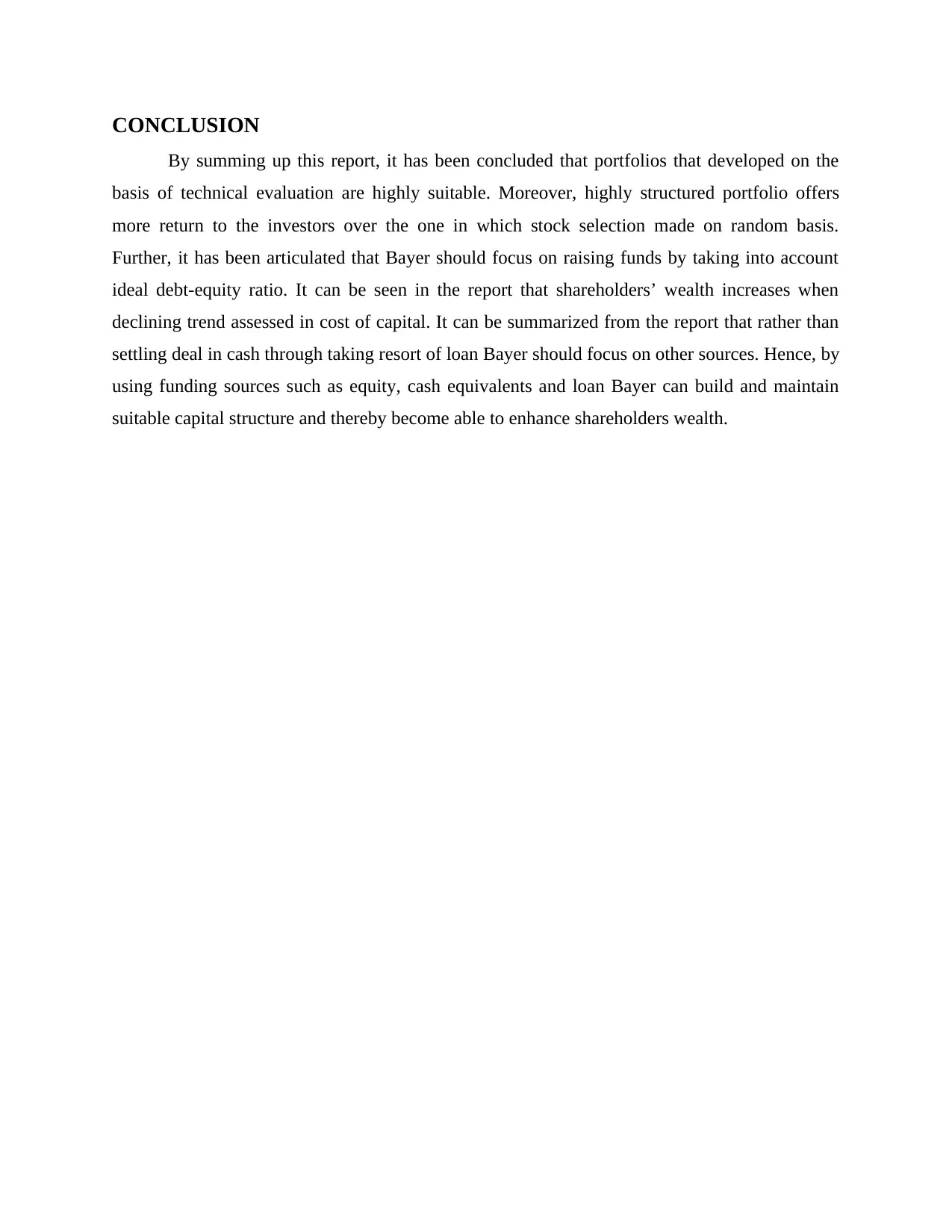
CONCLUSION
By summing up this report, it has been concluded that portfolios that developed on the
basis of technical evaluation are highly suitable. Moreover, highly structured portfolio offers
more return to the investors over the one in which stock selection made on random basis.
Further, it has been articulated that Bayer should focus on raising funds by taking into account
ideal debt-equity ratio. It can be seen in the report that shareholders’ wealth increases when
declining trend assessed in cost of capital. It can be summarized from the report that rather than
settling deal in cash through taking resort of loan Bayer should focus on other sources. Hence, by
using funding sources such as equity, cash equivalents and loan Bayer can build and maintain
suitable capital structure and thereby become able to enhance shareholders wealth.
By summing up this report, it has been concluded that portfolios that developed on the
basis of technical evaluation are highly suitable. Moreover, highly structured portfolio offers
more return to the investors over the one in which stock selection made on random basis.
Further, it has been articulated that Bayer should focus on raising funds by taking into account
ideal debt-equity ratio. It can be seen in the report that shareholders’ wealth increases when
declining trend assessed in cost of capital. It can be summarized from the report that rather than
settling deal in cash through taking resort of loan Bayer should focus on other sources. Hence, by
using funding sources such as equity, cash equivalents and loan Bayer can build and maintain
suitable capital structure and thereby become able to enhance shareholders wealth.
⊘ This is a preview!⊘
Do you want full access?
Subscribe today to unlock all pages.

Trusted by 1+ million students worldwide
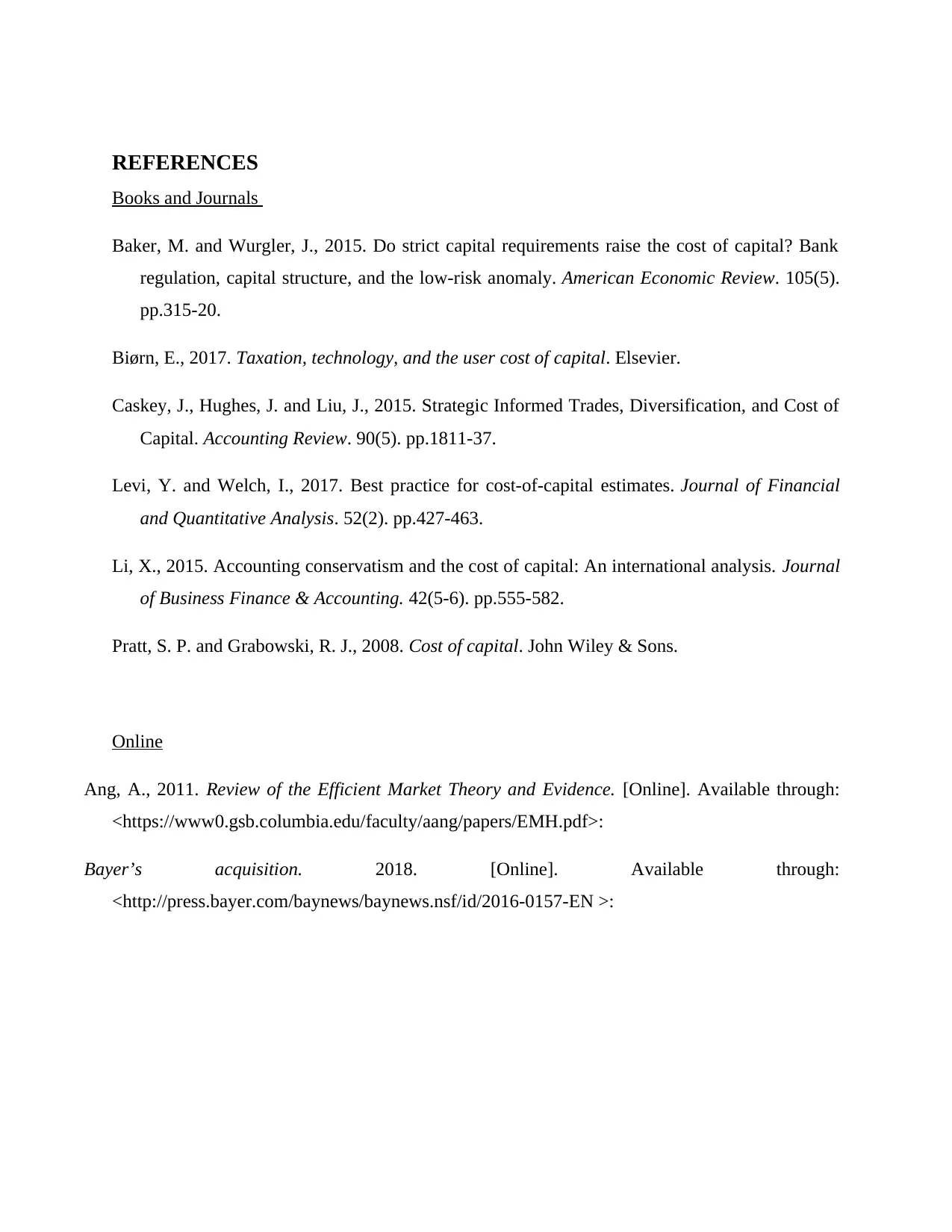
REFERENCES
Books and Journals
Baker, M. and Wurgler, J., 2015. Do strict capital requirements raise the cost of capital? Bank
regulation, capital structure, and the low-risk anomaly. American Economic Review. 105(5).
pp.315-20.
Biørn, E., 2017. Taxation, technology, and the user cost of capital. Elsevier.
Caskey, J., Hughes, J. and Liu, J., 2015. Strategic Informed Trades, Diversification, and Cost of
Capital. Accounting Review. 90(5). pp.1811-37.
Levi, Y. and Welch, I., 2017. Best practice for cost-of-capital estimates. Journal of Financial
and Quantitative Analysis. 52(2). pp.427-463.
Li, X., 2015. Accounting conservatism and the cost of capital: An international analysis. Journal
of Business Finance & Accounting. 42(5-6). pp.555-582.
Pratt, S. P. and Grabowski, R. J., 2008. Cost of capital. John Wiley & Sons.
Online
Ang, A., 2011. Review of the Efficient Market Theory and Evidence. [Online]. Available through:
<https://www0.gsb.columbia.edu/faculty/aang/papers/EMH.pdf>:
Bayer’s acquisition. 2018. [Online]. Available through:
<http://press.bayer.com/baynews/baynews.nsf/id/2016-0157-EN >:
Books and Journals
Baker, M. and Wurgler, J., 2015. Do strict capital requirements raise the cost of capital? Bank
regulation, capital structure, and the low-risk anomaly. American Economic Review. 105(5).
pp.315-20.
Biørn, E., 2017. Taxation, technology, and the user cost of capital. Elsevier.
Caskey, J., Hughes, J. and Liu, J., 2015. Strategic Informed Trades, Diversification, and Cost of
Capital. Accounting Review. 90(5). pp.1811-37.
Levi, Y. and Welch, I., 2017. Best practice for cost-of-capital estimates. Journal of Financial
and Quantitative Analysis. 52(2). pp.427-463.
Li, X., 2015. Accounting conservatism and the cost of capital: An international analysis. Journal
of Business Finance & Accounting. 42(5-6). pp.555-582.
Pratt, S. P. and Grabowski, R. J., 2008. Cost of capital. John Wiley & Sons.
Online
Ang, A., 2011. Review of the Efficient Market Theory and Evidence. [Online]. Available through:
<https://www0.gsb.columbia.edu/faculty/aang/papers/EMH.pdf>:
Bayer’s acquisition. 2018. [Online]. Available through:
<http://press.bayer.com/baynews/baynews.nsf/id/2016-0157-EN >:
1 out of 19